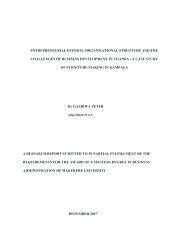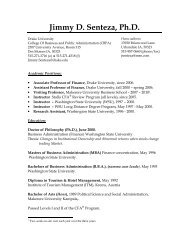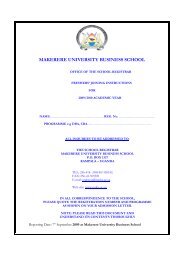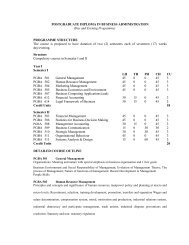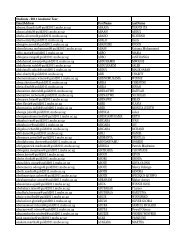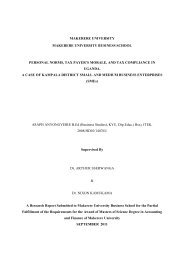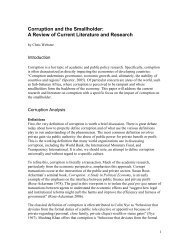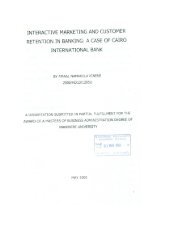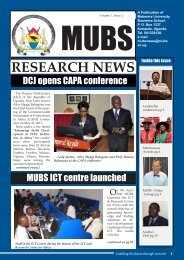13th Annual International Management Conference Proceeding
13th Annual International Management Conference Proceeding
13th Annual International Management Conference Proceeding
You also want an ePaper? Increase the reach of your titles
YUMPU automatically turns print PDFs into web optimized ePapers that Google loves.
population in Kenya especially in areas of dealerships 2 simu ya jamii (community phones) and what is commonly called<br />
ongea 24/7 dealers (pre paid electronic airtime vending system using mobile handsets). The majority of those venturing<br />
into these businesses though educated do not have the necessary management and leadership skills (NESC, 2006). And<br />
emerging problems of disguised unemployment especially in the public sector, it is argued that any solution to the<br />
current problem of high unemployment must therefore address this sector and the challenges arising there from.<br />
The capacity of SME’s to analyze and understand their internal and external environment and adopt their strategies with<br />
new conditions can help them to respond appropriately to these challenges. However, some do this more consciously and<br />
successfully than others. This paper’s premise is that by facilitating an understanding of management and leadership<br />
capacities, and how they can be strengthened, this may help SMEs increase their effectiveness. It reviews current<br />
thinking, drawing on literature from fields such as organizational learning and change, strategic management, systems<br />
thinking and complexity theory. It then proposes a number of considerations that may guide efforts to develop<br />
management and leadership competencies particularly of emerging or entry level businesses with specific reference to<br />
mobile telephone service vendors.<br />
PURPOSE OF THE REVIEW<br />
The management of small and medium enterprises considering that there are no entry and exit barriers is inundated by<br />
multiple and diverse problems. The recently launched Vision 2030 for Kenya identifies a number these challenges to<br />
accelerated economic growth as unemployment (especially among the youth as most jobs can be found in the informal<br />
sector), rising disparities in income (hence the need for income redistribution), rapid urbanization (at a rate of 6% per<br />
annum) and low savings ratio (16%) compared to the need. Given that urban areas will hold 60% of Kenya’s population<br />
by the year 2030, then it is imperative that the economy must grow as projected at a rate of 10% and in the identified<br />
growth areas. A critical challenge to unlocking the potential to this growth is the consolidation of the gains already<br />
witnessed in the growth of the mobile telephony service sector that holds the key to economic growth through<br />
generation of employment opportunities to absorb the large army of unemployed and particularly the youth. Studies<br />
show that there is a high correlation between high mobile subscriptions or penetration and GDP growth not only in<br />
Africa but in the developed works as well. In Kenya, the government has also recognized the vital role that this sector<br />
plays in development and GDP growth as evidenced in the latest review of progress made towards implementation of the<br />
economic recovery strategy for wealth and employment creation.<br />
With an exponential growth 3 in the mobile telephony sector and the many entrants (no literature on entry and exit) in<br />
the form of dealerships, simu ya jamii as well as ongea 24/7 dealers, this has tended to accelerate business dynamics that<br />
has boosted the growth in subscriber base. The entrants to this sector in the three forms identified above do face a range<br />
of challenges that forms the thesis of this paper. As new entrants and although well educated, they often lack skills in<br />
management and leadership which leaves them figuratively putting out fires on a daily basis in a bid to gain both intra<br />
and entrepreneurial capacity at a personal as well as organizational levels. Although there is consensus that small and<br />
medium sized enterprises will fuel job creation, one pertinent question remains, how many of the people going into such<br />
businesses as witnessed in the phenomenal growth of the mobile telephony sector have experience and knowledge of how<br />
to use analytical and adaptive capacities to cope with the challenges of this new and rapidly changing technology based<br />
business ventures.<br />
METHODOLOGY<br />
By and large, this was a desk study that focused primarily on reviewing literature on leadership and how this can be<br />
configured to the unique needs of mobile phone vendors. However, as great limitation to the review was that the<br />
reviewer is not a leadership theorist. The analysis of information reviewed and presented should therefore be viewed in<br />
the context of the reviewer’s institutional affiliation which has a focus on capacity building i.e. arising from the review,<br />
one question that the reviewer kept asking himself was what kind of training programs can be developed to target this<br />
market niche?<br />
2 Dealerships are well established businesses (at the apex of the entrepreneurship funnel) whereas simu ya<br />
jamii and 24/7 as well as other community phone services are still at the entry level and characterized by a<br />
number of vexing problems<br />
3 The number of mobile phone connections were at par with fixed land line connections at approximately<br />
300,000 in the year 2001, compared to 4.6million and less that 0.3 million respectively in 2005 (fixed line<br />
teledensity dropped)<br />
11



